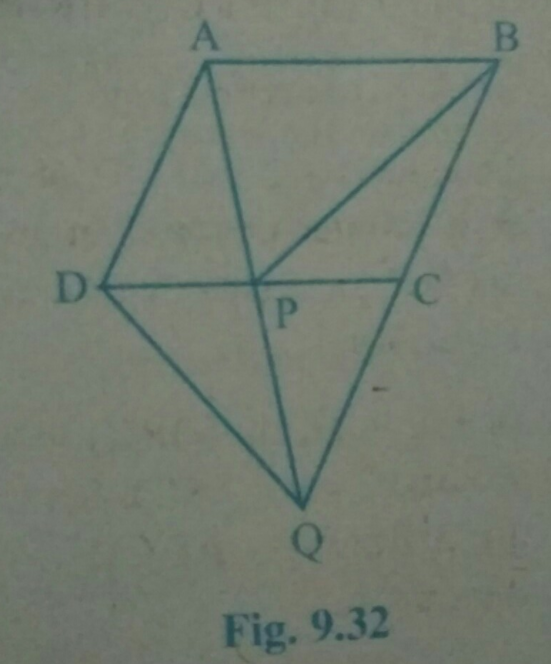In Fig. 9.32, ABCD is a parallelogram and BC is produced to a point Q such that. If AQ intersect DC at P, show that

It is given that is a parallelogram.
and (Opposite sides of a parallelogram are parallel to each other).
Now, join the points A and C.
Consider and
and are lying on the same base and between the same parallels
According to Theorem 9.2:
Two triangles on the same base (or equal bases) and between the same parallels are equal in area.
Therefore,) ...(1)
In quadrilateral , it is given that
Since is a parallelogram,
(Opposite sides of a parallelogram are parallel)
is a line segment that is obtained when line segment is produced.
We have,
and
Hence, is a parallelogram.
Consider and
These are on the same base and between the same parallels and
Therefore,
[Subtracting () on both sides.]
...(2)
From equations (1) and (2), we obtain
proved.
Topper's Solved these Questions
- AREAS OF PARALLELOGRAMS AND TRIANGLESBOOK - NCERT ENGLISHCHAPTER - AREAS OF PARALLELOGRAMS AND TRIANGLESEXERCISE - EXERCISE 9.1
1 Videos
- AREAS OF PARALLELOGRAMS AND TRIANGLESBOOK - NCERT ENGLISHCHAPTER - AREAS OF PARALLELOGRAMS AND TRIANGLESEXERCISE - Solved Examples
4 Videos
- AREAS OF PARALLELOGRAMS AND TRIANGLESBOOK - NCERT ENGLISHCHAPTER - AREAS OF PARALLELOGRAMS AND TRIANGLESEXERCISE - Exercise 9.3
16 Videos
- CIRCLESBOOK - NCERT ENGLISHCHAPTER - CIRCLESEXERCISE - Exercise 10.3
3 Videos
Similar Questions
ABCD is a parallelogram whose diagonals AC and BD intersect at O. A Line through O intersects AB at P and DC at Q. Prove that ar(POA)=ar(QOC).
View SolutionABCD is a parallelogram. A circle through A, B is so drawn that it intersects AD at P and BC at Q. Prove that P, Q, C and D are concyclic.
View SolutionIn Figure, ABCD is a parallelogram in which P is the mid-point of DC and Q is a point on AC such that CQ=14AC. If PQ produced meets BC at R, prove that R is a mid-point of BC.
View SolutionABCD is a parallelogram. P is the mid-point of AB.BD and CP intersect at Q such that CQ:QP=3:1. If ar (PBQ)=10 cm2, find the area of parallelogram ABCD
View SolutionABCD is a parallelogram. P is a point on AD such that AP=13AD and Q is a point on BC such that CQ=13BP . Prove that AQCP is a parallelogram.
View SolutionABCD is a parallelogram. P is a point on AD such that AP=13 AD and Q is a point on BC such that CQ=13BC. Prove that AQCP is a parallelogram.
View SolutionP and Q are any two points lying on the sides DC and AD respectively of a parallelogram ABCD. Show that ar (APB) = ar (BQC).
View SolutionIn Figure, ABCD is a parallelogram in which P is the mid-point of DC and Q is a point on AC such that CQ=14AC. If PQ produced meets BC at R. Prove that R is a mid-point of BC.
View SolutionIn ABC,D is the mid-point of AB,P is any point of BC.CQPD meets AB in Q . Show that ar(BPQ)=12ar(ABC).
View SolutionThe side AB of a parallelogram ABCD is produced to any point P. A line through A and parallel to CP meets CB produced at Q and then parallelogram PBQR is completed. Show that ar (ABCD) = ar (PBQR).
View Solution
